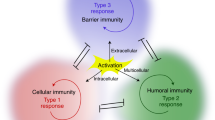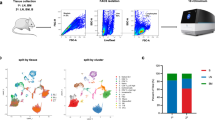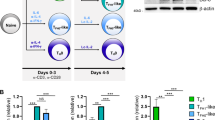Abstract
The interaction between helper T cells and B cells, leading to the production of antibody to thymus-dependent antigens, was the first cell interaction clearly defined in the immune system1–3; it remains both paradigmatic and controversial. Two requirements of this interaction, that the helper cell (TH) and the B cell must recognize antigenic determinants that are physically linked4,5, and that the TH and the B cell must share genes encoding major histocompati-bility complex (MHC) class II molecules6, led to the concept that TH–B interaction required an intimate physical association of the two cell types. But in vitro studies have shown that TH can be replaced by soluble, antigen-nonspecific factors, capable of activating any B cell to secrete antibody7,8. We have previously proposed that the requirements for TH–B contact might result from TH cells releasing their lymphokines in a polar fashion directed at that portion of the cell membrane where T-cell receptor cross-linking is actually occurring9–16. Using an artificial monolayer of a cloned helper T-cell line, we show that lymphokines are r eleased preferentially over the area of receptor cross-linking under conditions of limited TH-cell activation. Thus, it appears that one important aspect of the specificity of TH–B cell interactions is the receptor-directed polar release of helper lymphokines.
This is a preview of subscription content, access via your institution
Access options
Subscribe to this journal
Receive 51 print issues and online access
$199.00 per year
only $3.90 per issue
Buy this article
- Purchase on Springer Link
- Instant access to full article PDF
Prices may be subject to local taxes which are calculated during checkout
Similar content being viewed by others
References
Claman, H. N., Chapron, E. A. & Triplett, R. F. Proc. Soc. exp. Biol. Med. 122, 1167–1171 (1966).
Davies, A. J. S., Leuchars, E., Wallis, V., Marchant, R. & Elliott, E. V. Transplantation 5, 222–230 (1967).
Mitchell, G. F. & Miller, J. F. A. P. J. exp. Med. 128, 821–837 (1968).
Rajewsky, K., Schirrmacher, V., Nase, S. & Jerne, N. K. J. exp. Med. 129, 1131–1143 (1969).
Mitchison, N. A. Eur. J. Immun. 1, 18–27 (1971).
Katz, D. H., Hamaoka, T. & Benacerraf, B. J. exp. Med. 137, 1405–1420 (1973).
Schimpl, A. & Wecker, E. Nature 226, 658–660 (1970).
Dulton, R. W. et al. Prog. Immun. 1, 355–368 (1971).
Tite, J. P., Kaye, J. & Jones, B. Eur. J. Immun. 14, 553–561 (1984).
Tite, J. & Janeway, C. A. Eur. J. Immun. 14, 878–886 (1984).
Tite, J. P., Powell, M. B. & Ruddle, N. H. J. Immun. 135, 25–33 (1985).
Jones, B., Tite, J. P. & Janeway, C. A. J. Immun. 136, 348–356 (1986).
Janeway, C. A. et al. J. Immun. 135, 739s–742s (1985).
Janeway, C. A. et al. in Symposium on Fundamental Cancer Research, Vol. 38, 45–61 (University of Texas Press, Austin, 1986).
Jones, B. & Janeway, C. A. Nature 292, 547–549 (1981).
Tite, J. P. & Janeway, C. A. J. molec. cell. Immun. 1, 253–265 (1984).
McGee, H. J., Long, S. R. & Briggs, W. R. Nature 308, 667–668 (1984).
Kaye, J. et al. J. exp. Med. 158, 836–856 (1983).
Kaye, J. & Janeway, C. A. J. exp. Med. 159, 1397–1412 (1984).
Kaye, J. et al. J. Immun. 133, 1339–1345 (1984).
Tite, J. P. et al. J. exp. Med. 163, 189–202 (1986).
Kupfer, A., Swain, S. L., Janeway, C. A. & Singer, S. J. Proc. natn. Acad. Sci. U.S.A. 83, 6080–6083 (1986).
Kupfer, A., Singer, S. J., Janeway, C. A. Jr & Swain, S. L. Proc. natn. Acad. Sci. U.S.A. 84, 5888–5892 (1987).
Saizawa, K., Rojo, J. & Janeway, C. A. Jr Nature 328, 260–263 (1987).
Lichtman, A. H., Kurt-Jones, E. A. & Abbas, A. K. Proc. natn. Acad. Sci. U.S.A. 84, 824–827 (1987).
Killar, L., MacDonald, G., West, J., Woods, A. & Bottomly, K. J. Immun. 138, 1674–1679 (1987).
Kim, J., Woods, A., Becker-Dunn, E. & Bottomly, K. J. exp. Med. 162, 188 (1985).
Rock, K. L., Benacerraf, B. & Abbas, A. K. J. exp. Med. 160, 1102–1113 (1984).
Lanzavecchia, A. Nature 314, 537–539 (1985).
Author information
Authors and Affiliations
Rights and permissions
About this article
Cite this article
Poo, WJ., Conrad, L. & Janeway Jr, C. Receptor-directed focusing of lymphokine release by helper T cells . Nature 332, 378–380 (1988). https://doi.org/10.1038/332378a0
Received:
Accepted:
Issue Date:
DOI: https://doi.org/10.1038/332378a0
This article is cited by
-
How B cells capture, process and present antigens: a crucial role for cell polarity
Nature Reviews Immunology (2013)
-
Centriole polarisation to the immunological synapse directs secretion from cytolytic cells of both the innate and adaptive immune systems
BMC Biology (2011)
-
Sustained signaling by canonical helper T cell cytokines throughout the reactive lymph node
Nature Immunology (2010)
-
Mechanisms and functions for the duration of intercellular contacts made by lymphocytes
Nature Reviews Immunology (2009)
-
ASMase: the tailor of cytotoxic T cell granule exocytosis
Nature Immunology (2009)
Comments
By submitting a comment you agree to abide by our Terms and Community Guidelines. If you find something abusive or that does not comply with our terms or guidelines please flag it as inappropriate.



